I’ve learned about microfibers shedding and contamination out water a little over 1 year ago. With more research comes more knowledge, more fear, greater responsibility. Plastic literally penetrates every single aspect of our lives. Shortly after learning about microplastics in our rivers, I looked into filtering options. Does Guppyfriend bag work? Is it worth buying? I’ve been using it for almost a year and this is my Guppyfriend bag review.
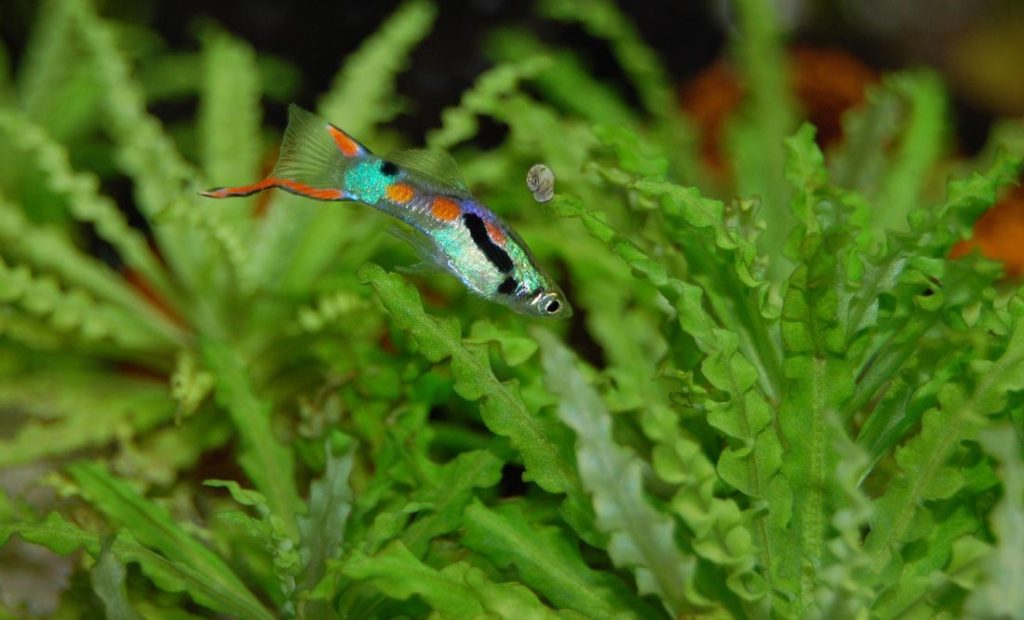
Microplastic has been found on all continents, in all of our waters: oceans, rivers, ponds, rural creeks, but it recirculated to our soil, and is now also found in our fruit and veg.
How does microplastic get into our water?
Our plastic-made clothes shed plastic
Nowadays, most of the clothes are made out of plastic, or a blend of plastic and natural fibers. When we wash them, they break apart, and particles hardly or not really visible to the human eye release into our waterways. Water treatment plants filter about 60% of microfibers.
The recovered microfiber mass per garment ranged from approximately 0 to 2 g, or exceeding 0.3% of the unwashed garment mass. Microfiber masses from top-load machines were approximately 7 times those from front-load machines.
Microfiber Masses Recovered from Conventional Machine Washing of New or Aged Garments
The number is per garment, per wash. Guppyfriend calculated that to be the volume of the city the size of Berlin (how did they calculate that?) or approx. 500,000 plastic bags – every single day.
Even when we buy second-hand clothing, fleeces from ethical brands that use recycled polyester or better yet, clothing made out of recycled ocean plastic, we return bits of plastic back into circulation every time we wash them.
There is plastic in our washing detergents
Another way of getting microplastic in the water is simply by putting it in out washing detergents, like a lot of brands do. Sadly, plastic in detergents is allowed and unregulated, the producers actually do not have to list it as an ingredient (or any other ingredient for that matter).
Read more about zero waste laundry detergents and how to make your whole laundry process plastic-free.
When we wash ourselves…
Our cosmetics and soaps also contain plastic, not only micro beads for peeling.
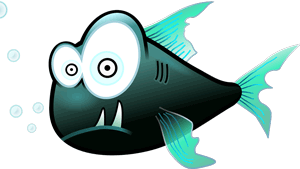
Why did I buy the Guppyfriend instead of a filtering system?
As first, I was looking at other options to contain microplastic in my washing machine, and microplastic filters that can be installed in our washing machines already exist. However, they are another cost for washing machine manufacturers, that they don’t want since it’s not contributing to their bottom line. The governments aren’t requiring them to be responsible. There are already plastic filters for consumers, but they come with a regular subscription model, you need to replace it regularly (extra waste). I strongly disagree that all the microplastic in the world should be solved by the consumer directly. Same as with Coca-Cola and other major plastic polluters, it’s the manufacturers that take zero responsibility for the disposal of their products. It is our governments that allow loose (or zero) regulations. The long term solution getting non-plastic clothes and creating fabrics that do not shed. But until something changes, I got myself a Guppybag.
The Guppybag was a much simpler solution compared to built-in filtration. It is 1 item, no replacements, no recurring costs, and the material was developed and tested to be high quality, so it should last OK.
Does Guppyfriend reduce microplastic pollution?
I had a healthy dose of scepticism at first and then decided to test it myself.
As it turns out, the Guppybag does work. Every time I use it, I get visible balls particles, bunched up in the corners.
I did however have this instinct to rinse the bag away after use, which is very lame. I still consciously tell myself every time, do not wash away. I guess they predicted that, because the bag actually says “do not rinse. residues must be collected and disposed of properly” right under capitalised “STOP!MICRO WASTE”. Smart.
It is made out of a special polyamid.
Classic size is 50 x 74 cm or 19,7 x 29,1 inches.
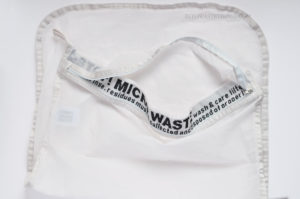
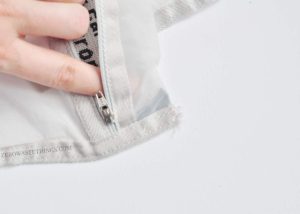
Getting the plastic particles out of the bag. 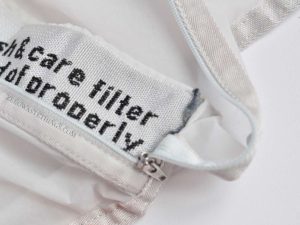
Plastic lint gets trapped on both sides (and a bit in the bottom). 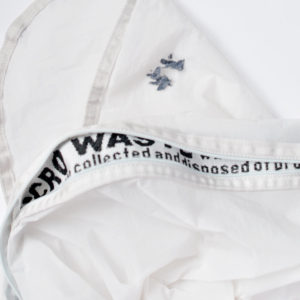
1 load worth: 2 Uniqlo Heattech sweaters (viscose) and 1 cotton-poly blend pants. I couldn’t believe it, the sweaters do not shed at all – they are actually very smooth.
Guppyfriend bag review: positives
- it very obviously traps microwaste
- I like the big size: it’s big, for several sweaters or pants
- it has a safety pocket of the zipper, so it doesn’t catch on other clothes
- light + it dries fast
- can be used as delicates bag as well (2 in 1)
Guppyfriend bag review: negatives
- after a year of use, the ribbon on the corners started to fray a bit – it still seals perfectly, buy…hej
- price
- made in China
What fabrics exactly should you put in the bag?
I put the Guppyfriend bag in any load together with the rest of my clothes.
And I opt to put all my synthetics in, not just fleece. The reason being is, that the shedding of microfibers depends on different polymer types, origins, yarn size, length, brightness, cutting/sewing methods, age…
A study published in 2020 they tested 12 different textiles and they all shed, though some more than others. The study was sponsored by Procter & Gamble, a manufacturer of detergents and fabric softeners, but I can’t see reasons for them to skew results. We also have several studies saying that the use of detergent increases fiber loss, some saying it doesn’t or makes little difference (I didn’t check them all or their big daddy bosses). It’s hard to compare since they didn’t use the same machine, water, detergent, fabrics etc. It stands to reason, that anything that gentle on the clothes creates less fraying, with is lower temps and liquid SLS-free detergent.
Where can you buy the Guppyfriend?
I actually got it at my local Jack Wolfskin store, but you can also get them online via Patagonia website or obvious, Amazon.
If you buy via their official website, shipping is free within Europe.
All the shops I saw, say they sell it with no profit for them – the fabric material was lengthy and costly (another reason to get our microplastic producing fashion brands to contribute to new research) and there was no difference in price.
I also saw smaller versions in a grocery store as a part of a special one off offer, but those would maybe be good for 1 sweater. Very small and not economical.
To recap Guppyfriend bag review
My review of the Guppy bag is very positive. Use it with all synthetic fabrics. I recommend buying the bigger (standard) size. Never rinse the gunk into a sink.
Over to you
Did you know about microplastic in our waters? What is your solution?

